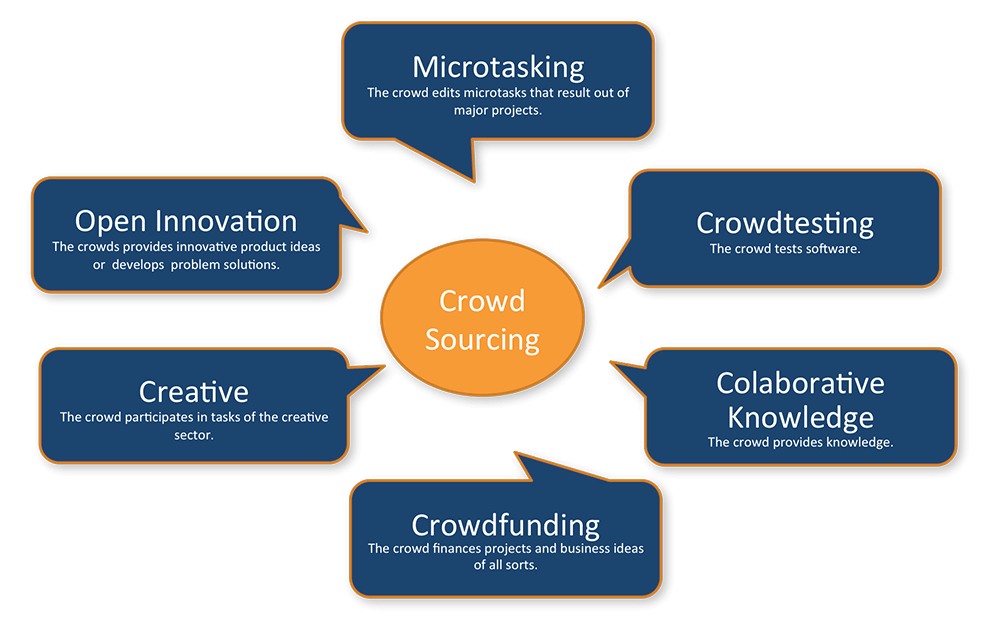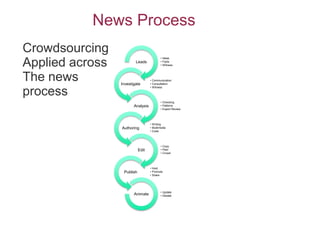In the ever-evolving landscape of journalism, crowdsourcing has emerged as a powerful and transformative tool. This innovative approach to reporting leverages the collective intelligence, skills, and resources of the public, creating a symbiotic relationship between journalists and the audience. With the advent of digital technology and social media, crowdsourcing has become an indispensable asset for journalists, allowing them to access a wealth of information, diverse perspectives, and unique stories that would have been otherwise inaccessible.
There are many different ways that journalists can use crowdsourcing. For example, they can crowdsource:
- Story ideas: Journalists can ask the public to submit story ideas, either through a general call or by asking specific questions.
- Information: Journalists can ask the public to share their knowledge and experiences on a particular topic. For example, they could ask people to share photos or videos from a news event, or to submit personal stories about a particular issue.
- Data: Journalists can crowdsource data to help them with their reporting. For example, they could ask people to fill out a survey or to participate in an experiment.
- Fact-checking: Journalists can crowdsource fact-checking to help them verify information. For example, they could ask people to review documents or to check the accuracy of online claims.
The Rise of Crowdsourcing in Journalism
Crowdsourcing in journalism is not a recent phenomenon but has gained significant prominence in the digital age. The 21st century has witnessed a paradigm shift in news gathering and dissemination. Traditional journalistic practices have been augmented by the engagement of the audience, as they are now integral participants in the news creation process. Social media platforms and online communities have provided a space for the public to actively contribute to news stories.

The idea is to tap into the collective WISDOM OF THE CROWD on any issue you are dealing with
:max_bytes(150000):strip_icc()/crowdsourcing.asp-final-7a1d5dcc4f3b45c38c0a5050354f66f4.png)
Make an open call
Making an open call in crowdsourcing refers to the process of inviting a diverse and broad audience to participate in a particular project or task. This open call is a fundamental step in crowdsourcing, as it is the means by which you engage a large number of individuals or a crowd to contribute their skills, knowledge, or resources to achieve a common goal. Here are the key steps and considerations when making an open call in crowdsourcing.
Defined and Undefined call
- Defined Call:
- A “defined call” in crowdsourcing might refer to a task or request that is well-specified and clearly defined. It means that the requester provides explicit instructions and guidelines for what they want from the crowd. This could include detailed descriptions, specific criteria for success, and clear objectives. Participants in a defined call typically have a clear understanding of what is expected of them, and the task is structured in a way that minimizes ambiguity.
- Undefined Call:
- Conversely, an “undefined call” could refer to a task or request that is less specific or lacks clear instructions. In this case, the requester may present a problem or question to the crowd without providing explicit guidelines on how to solve it. Participants are expected to use their creativity or judgment to address the task based on their own interpretation. Undefined calls may be used when the requester is seeking innovative or diverse solutions and is open to a broader range of responses.
Bound and Unbound call
- Unbound Call:
- An unbound call is a request for input or contributions from a crowd of workers where there are no strict guidelines, limitations, or specific instructions provided to the workers.
- Workers are given a relatively open-ended task and are encouraged to use their own judgment and creativity to complete it.
- Unbound calls are often used when seeking diverse ideas, opinions, or solutions to a problem without imposing too many constraints on the workers’ responses.
- Bound Call:
- A bound call, on the other hand, is a request for input or contributions from a crowd of workers that comes with specific guidelines, constraints, or requirements.
- Workers are expected to follow predefined instructions or guidelines closely when completing bound call tasks.
- Bound calls are typically used when the requester wants workers to perform specific, structured tasks that must adhere to certain criteria or standards.
For example, if you were using a crowdsourcing platform to design a logo for your company, an unbound call might be a request for creative logo ideas without specifying colors, shapes, or fonts, allowing for a wide range of creativity. In contrast, a bound call might involve specifying that the logo must include certain colors, the company name, and a specific icon, limiting the creative freedom of the workers.
The choice between unbound and bound calls depends on the goals and requirements of the crowdsourcing project. Unbound calls can be more suitable for tasks that require creativity and diversity of ideas, while bound calls are more appropriate when precision and adherence to specific criteria are essential.
Crowd sourcing applied across the news process

Benefits of Crowdsourcing in Journalism
- Diverse Perspectives: Crowdsourcing allows journalists to tap into the collective knowledge of the audience. By involving the public in the news gathering process, media organizations can ensure that a wider range of voices, experiences, and perspectives are represented in their stories. This diversity fosters a more inclusive and well-rounded view of the news.
- Faster Reporting: In a world where news travels at the speed of light, crowdsourcing can significantly expedite the reporting process. Eyewitness accounts, photos, and videos shared by the public on social media can serve as real-time sources of information, enabling journalists to provide timely updates on breaking stories.
- Increased Access: Crowdsourcing allows journalists to access information and sources that may be otherwise unreachable. For investigative reporting, this can be a game-changer, as the public often holds valuable insights, documents, or evidence related to a story.
- Cost-Effective: Traditional investigative journalism can be expensive and resource-intensive. Crowdsourcing can help alleviate some of these financial burdens by leveraging the audience’s willingness to contribute their time, knowledge, and resources.
- Engagement and Trust: Involving the audience in the reporting process can strengthen trust and engagement with media organizations. People are more likely to trust news outlets that actively seek their input and value their contributions.
Challenges of Crowdsourcing in Journalism
- Verification: With the rise of fake news and misinformation, verifying user-generated content is a paramount challenge. Journalists must rigorously fact-check and authenticate the information received from the crowd to maintain their credibility.
- Ethical Concerns: Journalists must navigate ethical issues related to privacy and consent when using user-generated content. It’s crucial to respect individuals’ rights and ensure their safety when featuring them in stories.
- Quality Control: The quality of user-generated content can vary significantly. Journalists must sift through a multitude of submissions to find reliable sources and high-quality information.
- Crowd Bias: There’s a risk of biases within the crowd, as some contributors may have personal agendas or prejudices. Journalists must be vigilant in identifying and addressing bias
Impact on Modern Reporting
The integration of crowdsourcing has revolutionized modern journalism. It has enabled media organizations to diversify their sources, engage with the audience, and adapt to the fast-paced nature of news reporting. Crowdsourcing has become a valuable asset in investigative journalism, disaster reporting, and feature stories. Citizen journalists, who capture events firsthand, play a pivotal role in shedding light on stories that may otherwise go untold.

Leave a Reply